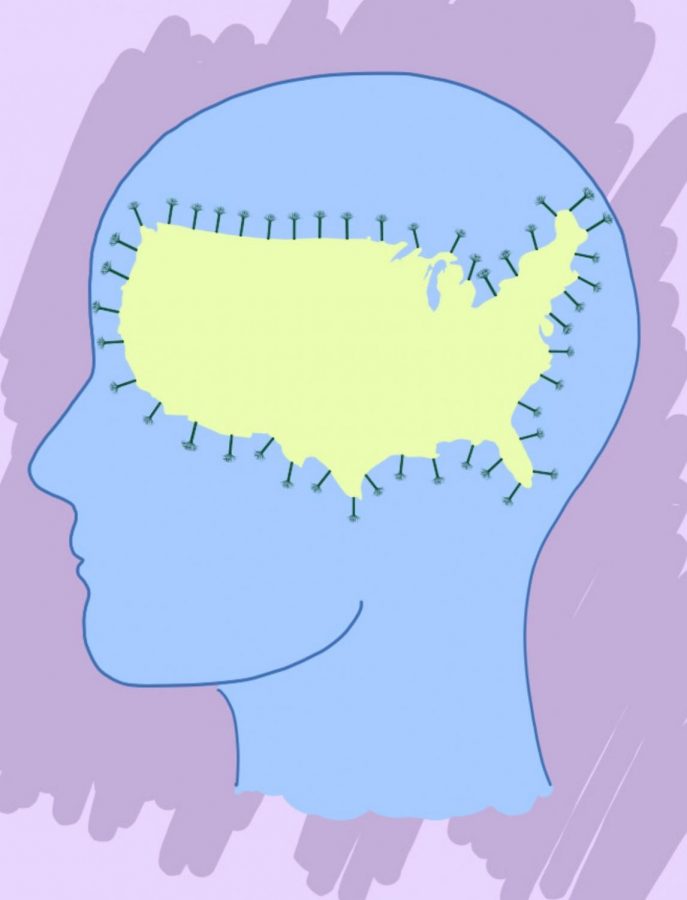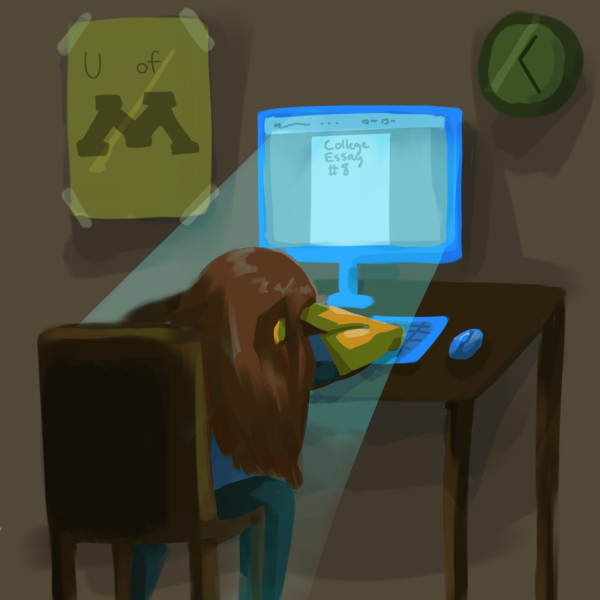A Craving For Control: How COVID 19 Is Taking A Toll On the Nation’s Mental Health
November 1, 2020
Walking down the street, almost everyone in sight seems to be wearing a mask. A good solution to preventing the spread of COVID 19, personal protective equipment is in mass production, is a minimal cost, and the personalization of hand-sewn masks allows people to express themselves as they choose. But what resources are available to Americans to mask their minds from intrusive thoughts, anxiety, depression, and other mental disorders during the pandemic? Resources don’t appear as readily available as the boxes of masks present on the shelf in every store, and therapeutic methods not covered by insurance haven’t trended cheap. How is the nation coping?
The statistics are clear: it is not. In the Morbidity and Mortality Weekly Report of August 14, 2020, the CDC reported the prevalence of anxiety disorder symptoms in the country had tripled from 8.1% in the second quarter of 2019 to 25.5% at press time. Comparably, symptoms of depressive disorders nearly quadrupled from 6.5% to 24.3% in the same time frame.
Due to primary factors including the heightened risk of unemployment, financial pressures, social isolation, the risk and fear of catching the disease, the virus’ high mortality risk, the availability of testing, limited understanding of how the virus may affect each individual, and no clear timeline of vaccine availability, the number of young adults who have reported seriously considering suicide has increased to 25.5%, and the gender gap in teen suicides continues to narrow.
Sadly, nearly two-thirds of these people suffering with a known mental disorder never seek help from a health professional, letting their thoughts fester and symptoms worsen. Stigma around having mental struggles makes it hard for individuals to reach out for help, making it unlikely for them to share their feelings for fear of judgement.
Unfortunately, for those who recognize the importance of stabilizing their mental health and do seek additional assistance, not many options are offered. Telehealth, occasional in-person therapy and psychiatric help are available, but for many, a weekly session with a counselor isn’t enough, requiring them to seek a higher level of care in either residential or inpatient facilities.
“Telehealth isn’t nearly as beneficial as in person care,” said Amy M., a Residential Care Specialist at Rogers Behavioral Health. “While there are limitations within residential and in-patient facilities because of COVID, treatment teams are still able to connect better with their patients and are able to read body language in meetings, whereas, over the phone, these symptoms can be minimized and distractions can impact the effectiveness of treatment.”
What’s worse, mental hospitals are reporting little to no vacancy, accumulating long waiting lists of desperate Americans.
“Mental health issues are just increasing, and we need to open up more facilities,” she continued. “Depression rates are going up, suicide rates are going up, divorce rates are going up; this virus is taking a toll on everybody.”
Slots are filling quickly as citizens recognize now is the time to act while every other aspect of their lives is awry, seeing that schooling is already primarily online and many activities can be continued from within these facilities. But this is not to say that people receiving intense treatment aren’t experiencing stress themselves.
Schooling hours and technology use are strictly limited within most facilities, limiting students from having the ability to log into virtual classrooms and participate in courses they signed up to take. Patients are required to drop classes they cannot maintain without being in the classroom, and the question of “Will I graduate on time?” looms over their heads, creating extra anxiety.
The real question is, why are these issues becoming prevalent? Many national leaders in the psychiatric field look to the one word answer: control. The uncertainty of the entire coronavirus situation causes unrest not only nationally, but globally as the general public looks to plan for their futures. Human beings crave security in having control over the future, and the fear and uncertainty about COVID 19 is leaving many feeling powerless over the direction of their lives. While people all have a different tolerance for levels of uncertainty, everyone has a limit, and the coronavirus seems to exceed this limit for many. Several people with excessive control issues develop mental disorders such as OCD and eating disorders, leaving them feeling purposeless and without any hope for the future.
So, how can one learn to cope with uncertainty, when the world seems like it won’t go on? Maintaining a certain mindset is key to learning how to accept the current circumstances. It is first important to understand uncertainty is an unavoidable part of life. The only thing truly constant in life is change, so it is necessary to have a mindset willing to adapt to the current circumstances. Most people resort to worrying in order to find peace, sorting through every possible outcome, looking for a solution and preparing for the worst. However, chronic worrying doesn’t give one more control over the uncontrollable events; it only suppresses one’s joy, making daily life less tolerable. Instead, one should try changing their mindset by following the following steps:
Focus on the little things that are under one’s control. By focusing on what is controllable, a person will transition from ineffective worrying and ruminating to participating in active problem-solving. Sometimes all that one can do is control their attitude and emotional response.
Actively deal with emotions by allowing oneself to experience the uncertainty and less pleasant emotions. By radically accepting the feelings one is experiencing rather than bottling up negative emotions, one may feel more at peace. If someone tries to deny or suppress their emotions, it may lead to higher stress and anxiety, additionally making one more vulnerable to depression and burnout.
Challenge the need for certainty. Instead of getting caught up in negative methods of coping such as reassurance-seeking, micromanaging, procrastinating, and checking things repeatedly, ask questions such as “What are the advantages and disadvantages of certainty?” and “Does uncertainty always lead to negative outcomes?” in order to challenge irrational thoughts.
Learn to accept uncertainty. Everyday activities such as getting behind the wheel, crossing the street, and eating takeout food already involve uncertainty– in each scenario, one is trusting their life to the hands of another. Irrational fears may seem impossible to conquer, but the same techniques used to accept the uncertainty of everyday situations can be used to overcome irrational fears. These include identifying one’s uncertainty triggers, recognising when one feels the need for certainty, and allowing oneself to feel the uncertainty. The uncomfortable feeling will pass–the anxiety just needs to be waited out. If one does not wait out the anxiety, they will never experience the downfall of it, causing the irrational fear to loom overhead even longer.
Focus on the present. The surest way to avoid worrying about the future is by staying present. Use mindfulness skills and practices to center yourself, focusing on the thoughts passing through the mind without judgement. Life will seem much more manageable taking it one breath at a time.
Manage stress and anxiety. Reducing overall stress can help with the process of interrupting negative thinking patterns. Making sure to be active, participating in enjoyable activities, leaving time to relax, getting good sleep, and eating properly are all essential to properly cope.
As always, school counselors are here to coach students through challenging times and intrusive thoughts as well. Make sure to reach out and set an appointment in the virtual office if help is needed.






























